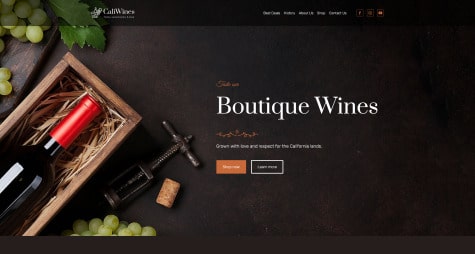Introduction
How to create a wine website? Any company, especially wineries, must have a strong web presence in the current digital era. By developing a wine website, you may promote your goods, inform your audience about various wines, and draw in new clients. This post will walk you through the process of developing a wine website that is pleasing to the eye, easy to use, and search engine optimized. https://diversewebsitedesign.com.au/winery-website-design/
Step 1: Define Your Objectives
It is crucial to outline your goals before starting the website creation process. Think about the goals you have for your wine website. Do you wish to give a wine tasting experience, sell wines online, or share information about your vineyard? Having a clear understanding of your goals will aid in your decision-making while you build your website.
Step 2: Choose a Domain Name and Web Hosting
The domain name for your wine website should be chosen as the next stage. Choose a name that people will remember, is pertinent to your business, and is simple to spell. Once you’ve decided on a domain name, register it with an established domain registrar. You should also pick a web hosting company that can meet your website’s requirements for storage, bandwidth, and security.
Step 3: Select a Content Management System (CMS)
You can maintain and change the content of your website more easily with a content management system (CMS). Popular CMS choices that provide versatility and user-friendly interfaces include WordPress, Joomla, and Drupal. Select a CMS that matches your level of technical proficiency and website requirements. Particularly WordPress, which has a sizable development community and plugins to improve the operation of your website.
Step 4: Design and Layout
Your wine website’s style and design are essential for drawing in and keeping visitors. When building the website, take your winery’s overall branding and concept into account. To provide your viewers an immersive experience, use high-quality pictures of your vineyard, wines, and wine-making procedure. Make sure the website’s design is user-friendly, with simple navigation menus and information that is simple to find.
Responsive Design
It is crucial to make sure that your wine website is responsive in today’s mobile-first environment. Your website can smoothly adjust to numerous screen sizes, including smartphones and tablets, thanks to responsive design. This guarantees that consumers, regardless of the device they are using, have a consistent and enjoyable surfing experience.
Color Scheme and Typography
Pick a color palette that captures the atmosphere and tone of your winery. To convey a feeling of class and elegance, think about utilizing warm, earthy colors. When choosing typography, choose legible typefaces that go well with your business identity. Serif and sans-serif fonts can be used together to offer aesthetic interest while yet preserving readability.
Step 5: Content Creation
For website visitors to be interested and for your wines’ distinctive traits to be communicated, you need compelling content. For every wine, write up appealing and educational descriptions that include background information, pairing ideas, and tasting comments. To capture your audience and create an emotional connection with your brand, incorporate storytelling elements. Additionally, think about including a blog section where you can publish informative articles, updates, and happenings in the wine industry. https://sugarwhipped.com.au/
Step 6: E-commerce Functionality
Integrating e-commerce capability into your website is essential if you intend to sell wines online. Select an online storefront that enables you to exhibit your products, control inventory, accept payments securely, and provide delivery alternatives. You may seamlessly incorporate well-known e-commerce platforms like WooCommerce, Shopify, and Magento into your wine website.
Step 7: Search Engine Optimization (SEO)
It’s crucial to optimize your wine website for search engines to make sure it performs effectively in search engine results. Conduct keyword research to find pertinent wine-related search terms, then thoughtfully use them in the content of your website. Add relevant keywords to your website’s headings, meta tags, and picture alt tags. To increase your website’s exposure and authority, concentrate on creating shareable content and high-quality backlinks.

Step 8: Testing and Launching
Test your wine website’s usability, responsiveness, and functionality in-depth before launching it. Verify all links are functional, increase page loading speed, and confirm that all forms and interactive features are functioning properly. To ensure consistent performance, test the website across a variety of browsers and platforms. It’s time to launch your wine website and begin promoting it to your target audience after you are happy with the results.
Conclusion
A wine website needs to be carefully planned, have great attention to detail, and focus on providing an outstanding user experience. You can build a successful wine website that draws visitors, promotes your wines, and helps your winery thrive in the digital landscape by clearly defining your objectives, selecting the ideal domain name and web hosting, selecting an appropriate CMS, designing an appealing layout, writing compelling content, incorporating e-commerce functionality, and thoroughly testing before launch.






